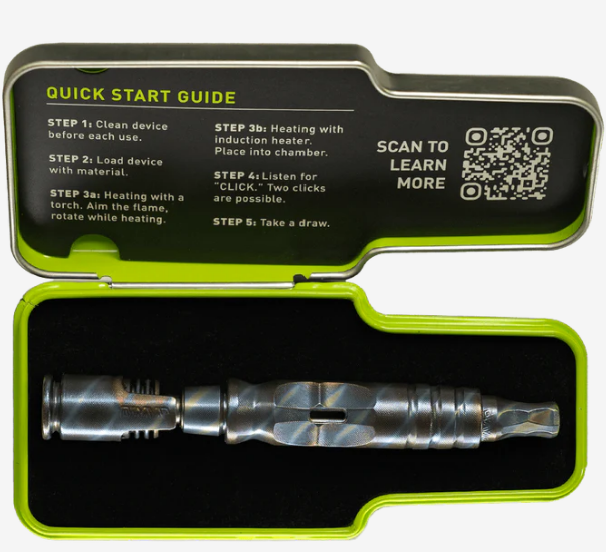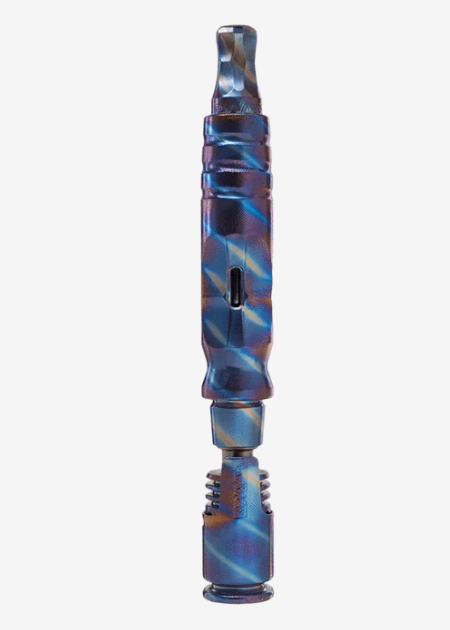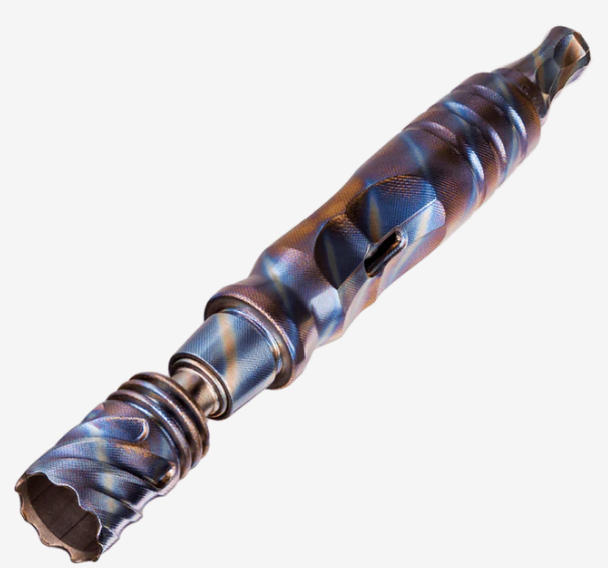Vapes for dry herbs are having a moment, and it is well deserved. The flavor is cleaner, the feel is smoother, and the whole experience is more controlled than old school combustion. You are not chasing burnt tastes or harsh pulls anymore. You are dialing in a temperature window where the good stuff wakes up and the irritants sit out. If you are new, that switch alone feels like stepping into a smarter lane.
Now, here is the twist a lot of people miss. Not every vape for dry herbs runs on batteries or screens or a maze of settings. Dynavap built a battery-free approach that is portable, modular, and shockingly precise once you catch the rhythm. You heat the cap with a torch or an induction heater, you listen for the click, and you are cruising in the vapor sweet spot. That is the signature move. It is simple, it is repeatable, and it turns beginners into confident operators fast.
This guide keeps the spotlight where it belongs, on the gear that actually changes your session. You will get straight talk on how Dynavap’s thermal extraction works, why the lineup hits different, and how to pull consistent, tasty vapor without guesswork.
To shed more light into this legendary brand, Dynavap is the only company out there that can deliver you high quality vaping through their dry herb vaporizers. Use the coupon code 25dyna25 and get a 20% discount on your next purchase.
Why Vapes for Dry Herbs Feel Different With Dynavap

Traditional smoking burns plant material, and that creates smoke, ash, and a flavor that goes downhill quick. Vapes for dry herbs take a cleaner path by heating the material to release active compounds as vapor.
Dynavap leans into that advantage with thermal extraction that is tight, quick, and portable. You heat the cap, wait for the click, and inhale smooth flavor that respects your terpenes. The result is a session that tastes fresh and lands predictably.
A big reason beginners vibe with Dynavap is the control loop. You are not guessing at a digital number or praying your battery lasts. You are driving heat with a torch or an induction heater, and the cap tells you when you are in the pocket. That feedback builds confidence in minutes. After a few cycles, you learn how long your heat takes, how your herb responds, and how to stretch a bowl without scorching it.
There is also the efficiency factor. Because you are heating only what you load and staying in that optimal range, vapes for dry herbs like these make your material go further. Dynavap devices are built to keep airflow moving, extraction even, and flavor on point. You taste more, you waste less, and you walk away with sessions that feel both lighter and stronger at the same time. That is the sweet spot most people are chasing.
Torch or Induction, Not Batteries
Here is the first thing to lock in. Dynavap devices are battery free. You will not be charging anything before you sesh, and you will not be stuck when a lithium cell decides to quit. You bring heat with a small butane torch or an induction heater, you apply it to the cap, and the device tells you when to hit it by clicking at temperature. It is quick, it is tactile, and it works anywhere you can spark or plug an induction base.
That click is not a gimmick. When the cap clicks, you are at the vaporization zone and good to inhale. After your draw, the cap cools and clicks again to signal it is out of the zone. If you want more, reheat to the next click and go again. This loop keeps extraction consistent for beginners and lets experienced users push harder when they want denser clouds. No screens to scroll, no mystery numbers, just audible feedback that lands every time.
If you are thinking about where to start, a single-flame torch is a clean entry. It heats predictably and makes learning the rotation easy. Once you have the rhythm, an induction heater is the definition of convenience. You dip the cap, wait for the click, and pull. Both options pair with every Dynavap device, so your heating style can evolve as your sessions do with high quality dry herb vaporizers.
Conduction, Convection, and the Dynavap Sweet Spot
People love to debate conduction versus convection in vapes for dry herbs. Conduction brings heat by contact, convection brings heat by moving hot air through the load. Dynavap rides a tuned blend that changes with your heat placement and draw. Warm the cap toward the tip, and you get punchy heat that ramps fast. Heat closer to the base of the cap, and you can coax more convection-style airflow through the bowl. Your technique shapes the profile.
Draw speed matters here. Slow, steady pulls invite warm air through the chamber and keep flavors bright. Longer, deeper pulls stack density if you preheat a touch longer before the click. Because you control the heat and the inhale, you tune the balance in real time.
That is why these devices feel so hands on. You are not stuck with whatever a chipset decided is “good.” You are cooking your bowl with intention and getting rewarded for the finesse.
Meet the Lineup You Will Actually Use

Dynavap’s best dry herb vaporizers are about feel, durability, and session style, not buttons and batteries. Each device follows the same “heat, click, inhale” flow, but the materials, chamber size, airflow control, and ergonomics change the experience.
If you are choosing your first vape for dry herbs, here is how the core pieces stand apart, and why each one could be your best first pick.
The “M” Series: The Battery-Free Workhorse That Stretches Your Stash
The “M” Series is the most approachable way to get into vapes for dry herbs without touching a battery. Built from medical grade stainless steel, it delivers flavorful vapor in seconds and stays consistent from session to session. You set your Stainless Steel CCD in the notch you want to choose your dose, you use the chiral airports to shape airflow, and you run tight, repeatable heat cycles that taste clean. It feels solid in the hand and holds up to daily use without drama.
One of the biggest wins with the M is efficiency. You will get 75% more from your material compared to wastey combustion. That is not hype, that is the design doing its job. Precise dosing plus audible heat feedback is a cheat code for beginners.
You do not need to fill a big oven or babysit a screen. You load, heat to the click, and draw. If you like to microdose, the dosing control makes tiny sessions feel perfect. If you want fuller extractions, the chamber handles that too.
Compatibility is clean and simple. The M is built for plant material right out of the box. If you want to venture into concentrates, you can add the DynaCoil adaptor and turn your setup into a concentrate-ready vaporizer. The core device stays the same, the experience stays consistent, and your learning curve stays low.
For a first Dynavap, this is the battery-free baseline that shows you how good vapor can be when the design gets out of the way.
The M7 and M7 XL: Bigger Rips, Cooler Fingers, Smoother Control
The M7 takes everything people love about the M line and turns the dials up. The tip has more mass for heat retention, which gives you greater control over one-hit extractions and thicker pulls. The finless tip design keeps your fingers cooler, which you will appreciate the first time you push back-to-back sessions. Extraction stays even thanks to refined chamber walls, so you are not chasing hot spots or stirring in frustration halfway through a bowl.
Airflow is where the M7 really flexes. The new airport design makes control more intuitive, and the “Pivot” style rocker lets you feather your draw in real time. More airflow comes from the redesigned captive cap fitment and increased convection, which translates to smooth vapor that rides easy while still hitting with presence. If you like tailoring your inhale to your mood, this setup makes that feel natural without a learning curve that scares beginners.
The M7 is also microdose ready with the “adjust-a-bowl,” which halves the chamber when you want tiny loads. It is built from medical grade stainless steel in the USA and tuned for durability, so it is ready for daily carry.
The Captive Cap still clicks at the optimal vaporization temperature and cools with a second click, keeping every cycle predictable. If you want longer form sessions, the M7 XL adds the XL condenser assembly and mouthpiece, which shifts the hand feel and balance in a way a lot of people love for relaxed, at-home vibes.
HyperDyn: Big Bowl Energy for Connoisseur Sessions
The Dynavap HyperDyn walks in with a completely different posture. This is Dynavap’s first big bowl vaporizer, and it is built for people who want a “session style” experience with heavy hits and serious stamina. The tip and cap combo is state of the art, the average chamber volume is about 0.25 grams, and the titanium build brings that crisp, responsive heat feel Dynavap is known for. If you like fewer reloads and bigger clouds, this is your lane.
Durability and finish are dialed. The HyperDyn uses medical grade titanium protected by DuraDyn technology, so it looks clean and resists scratches even when it is living in a pocket or bag. The stem is ergonomically designed for easy airport usage, and the device is machined in Wisconsin, USA, with a fit and finish that feels premium the second you touch it. It pairs with water pieces right out of the box thanks to built-in 10 mm and 14 mm tapers, which makes it a monster for cooled, dense pulls.
Airflow and modularity round out the story. The Hyper Cap is engineered to click at temperature, and the airflow is adjustable via the connection between the Hyper Tip and Hyper Cap. You also get seven unique airflow settings by changing condenser depth in the mouthpiece, so you can lock in your personal draw feel.
It remains modular with previous Dynavap midsections, tips, and mouthpieces, with one key note. The Hyper Cap fits only the Hyper Tip. If you want to cut the load in half for a quick break, the Hyper Dosing Capsule holds about 0.125 grams and drops in seamlessly.
How To Get Great Results From Vapes for Dry Herbs
You do not need a lab setup to pull flavor and density from vapes for dry herbs. You need a consistent grind, a sensible pack, and a draw that keeps airflow happy.
With Dynavap, those basics carry you further because the audible click keeps your heat cycle honest.
You do the little things right, and the device rewards you with smooth hits and bowls that seem to last longer than you expect.
Grind, Load, and Pack For Airflow
Start with a medium-fine grind. You want pieces small enough for hot air to move through evenly, but not powdery enough to choke a screen. That balance keeps extraction even and flavor bright. Scooping from a grinder straight into the tip helps you avoid packing too tight. If you are new, think “loose fill with a gentle tamp” instead of cramming. Air needs room to flow, and tight packs ruin airflow fast.
The goal is contact without compression. A light tamp seats the material so it does not shift when you draw, but it still leaves micro-channels for air. If you underpack, you lose efficiency because the heat has too much room and slips past the load.
If you overpack, you stall airflow and pull thin vapor even with perfect heating. The more you repeat this, the more muscle memory you build. After a week, you will load by feel and hit the sweet spot without thinking.
Master the Heat Cycle and the Click
Heat application is the entire game with battery-free vapes for dry herbs. Keep your flame just off the cap, rotate smoothly, and do not camp the flame in one spot. When you hear the click, stop heating and start your draw.
That pause between click and inhale is where flavor lives. If you want a heavier first hit later in the bowl, you can let the cap warm a touch longer before the click on a subsequent cycle, then pull with intent.
Cooling matters too. When the cap clicks again, you are out of the zone, and the bowl is ready for the next heat. Give it a moment to breathe before you reheat so you are not stacking heat faster than the cap can regulate.
That rhythm, heat to click, draw, cool to click, repeat, keeps performance consistent. Beginners pick it up fast, and it becomes second nature. You will even start to hear subtle differences in the click as your load progresses.
Induction heaters make consistency even easier. You dip the cap, watch or listen for the click, and pull. If you are the type who wants repeatable timing every cycle, induction is a clutch upgrade. Torches hit great and feel hands on, while induction feels like cruise control for your heat.
Both deliver. Choose the vibe that fits your space and flow.
Draw Technique That Delivers
Fast inhales do not do these devices any favors. Think slow, steady, and intentional. A controlled draw pulls warm air through the load and carries vapor into your lungs without turbulence. If your pull is too hard, you can thin out the vapor and even suck small particles toward the mouthpiece. Keep the draw smooth and let the device do the cooking for you.
Play with your airports. On the M and M7, feathering the airport changes resistance and shifts the balance between flavor and density.
The “Pivot” rocker on the M7 makes this extra intuitive, so you can go open and airy for bright terp notes or close it down for thicker, heavier hits. On the HyperDyn, condenser depth and the Hyper Tip-to-Cap connection give you more ways to shape intake. Tinker for a session or two, then lock in your favorite setting.
Finally, respect the bowl as it evolves. Early hits are flavor bombs. Middle hits stack density. Late hits finish extraction. If a pull starts to taste roasted, that is your cue that the load is mostly done.
Save your AVB if that is your thing, or clear the bowl and reload. Chasing flavor instead of forcing one more cloudy pull keeps your sessions tasting fresh and your throat feeling good.
FAQs
Are vapes for dry herbs beginner friendly with Dynavap?
Yes, and the learning curve is short because the device does the hardest job for you. Heat the cap with a torch or induction heater until it clicks, take a steady draw, and wait for the cool-down click before you reheat. That audible feedback is why beginners settle in fast.
Do Dynavap vapes need a lighter or a battery?
You will not be charging anything. Dynavap devices are battery free and run on external heat from a butane torch or an induction heater. A single-flame torch is perfect for learning rotations and timing, and an induction heater makes cycles ultra consistent. The cap is engineered to click when it reaches the optimal vaporization temperature and to click again when it cools.
How big are the bowls in the M, M7, and HyperDyn?
The M7 tip is microdose ready thanks to the adjust-a-bowl, which lets you reduce the chamber size by half when you want small, precise sessions. The M7 specification also lists a bowl size of about 0.1 grams, which is a sweet spot for fast, efficient extractions. The HyperDyn steps up to a larger average chamber of about 0.25 grams, which is why it feels like a “session style” device with fewer reloads. If you want to cut HyperDyn loads down, the Hyper Dosing Capsule holds about 0.125 grams and drops right into the tip.
Do vapes for dry herbs waste less herb with Dynavap?
They do, and that is one of the biggest reasons people switch. The M is known for getting 75% more from your material compared to combustion, which lines up with how tight thermal extraction can be when you respect the click. The M7 keeps that efficiency while adding smoother airflow and heat retention, and the HyperDyn stretches sessions with a bigger bowl that still extracts evenly. Less waste shows up as better flavor and fewer reloads, and your stash lasts longer without trying.
Can I use concentrates with these devices?
Yes, with the right setup. The M line is compatible with plant material out of the box, and you can use the DynaCoil adaptor to run concentrates. That swap lets you tap into a different style of session without changing your core routine. Load appropriately, heat to the click with a torch or induction heater, and draw steadily. Keep your device clean after concentrate sessions so airflow stays fresh and the next dry herb bowl tastes as bright as it should.
What is the best way to clean and maintain a Dynavap?
Keep it light and consistent. After sessions, brush the chamber so loose material does not bake into residue. Once a week if you use your device daily, disassemble and soak removable parts like mouthpieces and screens in isopropyl alcohol, rinse well, and dry completely.
